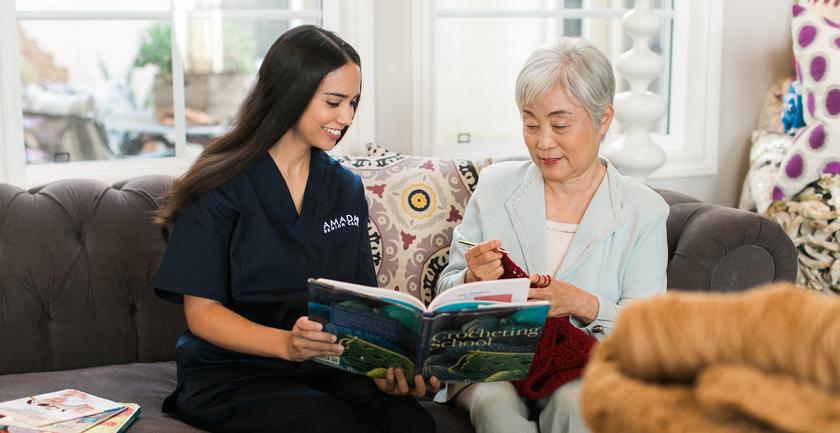- Categories :
- More
Six Ways to Smoothly Adjust to an In-Home Caregiver

For seniors who choose to age in their own homes, hiring a professional in-home caregiver can be an excellent solution. However, adapting to the presence of a caregiver, especially in one’s familiar environment, can be challenging for some seniors and may require time.
This adjustment is particularly sensitive given the caregiver’s role in assisting with personal care tasks such as bathing, dressing, and toileting. It’s essential that the senior feels entirely at ease with their chosen caregiver, given the personal nature of the tasks and the caregiver’s entry into the senior’s private living space, underscoring the need for a relationship grounded in trust.
Compassionate Caregivers Lean Into Adjustment Period for Seniors
To facilitate a smooth transition to in-home care, selecting a caregiver who can quickly establish a comfortable and trusting relationship with the senior is critical. Compassionate caregivers recognize the natural adjustment period many seniors go through and are patient and understanding through this phase.
A critical aspect of easing this transition is ensuring caregiver consistency. Most seniors develop a preference for a particular caregiver once a good match is found. It is then up to the home care agency and the family to not only find an appropriate caregiver but also to ensure this caregiver is consistently available for the senior. Introducing any backup caregivers to the senior beforehand can mitigate discomfort or unfamiliarity, ensuring continuity of care even when the primary caregiver is unavailable.
Transitioning to Acceptance of the Caregiver Role
Transitioning to life with a new caregiver isn’t always easy, especially for seniors who value their independence and routines. At Amada Senior Care, we understand the complexities and emotions involved in this significant change; that’s why our senior care advisors are dedicated to helping seniors and their families navigate this journey with grace and ease. Here are six expert recommendations to help seniors adjust to a new caregiver, ensuring a comfortable and positive experience.
-
Open Communication
Starting with open and transparent communication is key to building a strong foundation. Encourage seniors to share their preferences, routines, likes, and dislikes with their new caregiver. Similarly, caregivers should be open about their methods and listen to the senior’s needs and concerns. This exchange of information fosters respect and understanding from both sides.
Professional caregivers should aim to quickly form a rapport with elderly clients through engaging conversations and activities, creating a sense of companionship. Establishing a real connection requires effort from both sides to share and learn about each other. Since welcoming a new caregiver can initially feel uncomfortable, it often requires time for a senior to adjust to new personalities and ways of doing things.
-
Establish a Routine
Routine provides comfort and a sense of normalcy, which is especially important during times of change. Work together with the new caregiver to establish a daily routine that mirrors the senior’s previous schedules as closely as possible. This includes mealtimes, leisure activities, and any specific regimens (like medications or exercises) they need to follow.
-
Engage in Shared Activities
Finding activities that both the senior and caregiver enjoy can be a wonderful icebreaker and helps build a rapport. Whether it’s gardening, puzzles, walks, or cooking, shared activities encourage bonding and make the adaptation process more enjoyable for both parties.
Music has the power to connect people, invoke nostalgia, and ease anxiety. Playing favorite songs during visits can strengthen the bond between caregivers and seniors.
-
Give it Time
Adjusting to a new caregiver doesn’t happen overnight. It’s important for seniors and their families to give this transition some time. Patience is key. With each passing day, trust and familiarity grow, making the adjustment easier. It’s alright to take things one day at a time.
-
Feedback Loops
Setting up regular check-ins can significantly ease the transition. Feedback sessions allow everyone to express how they’re feeling about the new arrangement. This could be done through family meetings, or by having an intermediary from the senior care company facilitate these discussions. This is a constructive way to address any concerns and celebrate positive outcomes.
-
Professional Support
Lastly, don’t hesitate to seek professional support if the adjustment phase is particularly challenging. If a caregiver isn’t a suitable match, communicating this discrepancy to the home care agency is crucial to find a caregiver who better aligns with the senior’s needs and preferences.
Trust and Relatability Between Seniors and Caregivers
Transitioning to a new caregiver is a significant change, but it doesn’t have to be a daunting one. By promoting open communication, establishing a comfortable routine, engaging in shared activities, allowing enough time for adjustment, maintaining a feedback loop, and seeking professional support when necessary, seniors can smoothly adapt to their new caregiving arrangements.
Trust and relatability between the senior and their caregiver(s) are fundamental in creating an enjoyable home care experience. Once past the initial adjustment, seniors often look forward to the company and assistance provided by their in-home caregivers.
With the right approach and support, adjusting to a new caregiver can lead to new friendships, experiences, and a fulfilling caregiving relationship.


















